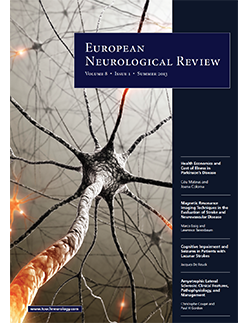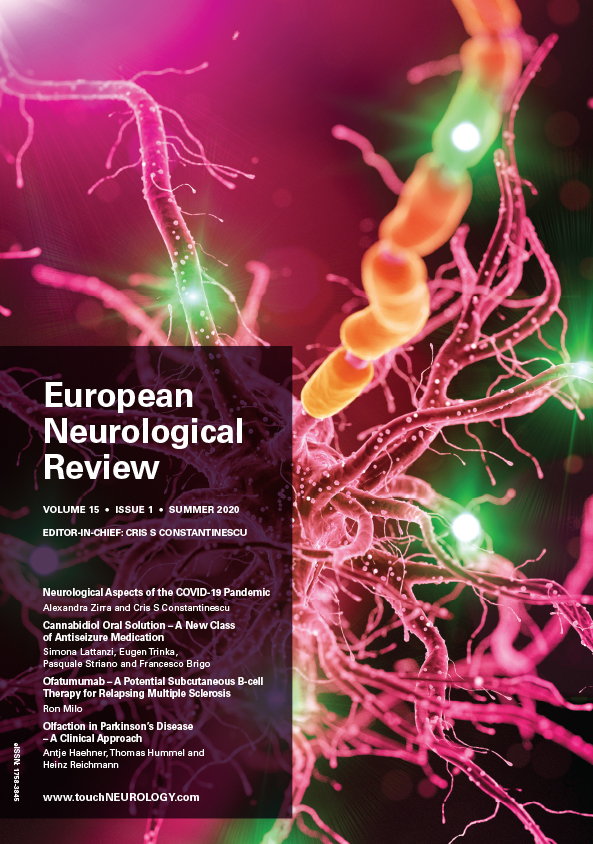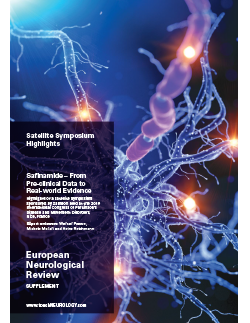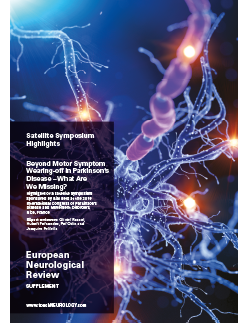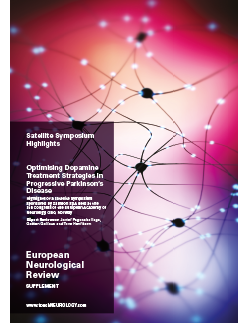EUROPEAN NEUROLOGICAL REVIEW – VOLUME 8 ISSUE 1 – SUMMER 2013
Welcome to the summer edition of European Neurological Review which features review articles on a broad variety of timely topics including Parkinson’s disease, stroke, neurodegenerative disease, amyotrophic lateral sclerosis and chronic inflammatory demyelinating polyneuropathy. This issue features an important article from Ceu Mateus exploring health economics and cost of illness aspects in Parkinson’s disease. Parkinson’s disease is the second most common neurodegenerative disorder worldwide and costs associated with the disorder are very high creating a difficult burden on both individuals and society. The journal also includes some interesting articles on therapeutic interventions in Huntington’s disease and epilepsy in children, stroke-related topics and auto-immune disorders of the brain.
It is a great pleasure to be invited to write the foreword of the 8.1 issue 2013 of the European Neurological Review. The present edition contains a large variety of neurological topics, covering health economics and cost illness aspects, therapeutical interventions in Huntington’s disease and epilepsy in children, stroke-related topics, auto-immune disorders of the brain, […]
Movement Disorders : Parkinson’s Disease
Parkinson’s disease (PD) is the second most common neurodegenerative disorder worldwide, the first being Alzheimer’s disease. In industrialised countries, PD has an estimated overall prevalence of 0.3 % and an estimated 1 % prevalence in the population of individuals over 60 years of age. PD disease manifests itself through neuromotor symptoms such as tremor, bradykinesia, […]
Huntington’s disease (HD) is a genetic disease with autosomal dominant transmission and is unique amongst neurodegenerative diseases in that predictive testing is available before clinical symptoms are evident.1 As such, individuals with a family history of HD can choose to be tested and can establish if they will eventually get the disease. Some individuals choose […]
Stroke
Stroke is the second most common cause of death and a major cause of disability worldwide. Because of the ageing population, the burden of stroke is likely to increase during the next 20 years, especially in developing countries.1 The majority (85 %) of strokes are ischaemic: patients present with asymptomatic bruits, transient ischaemic attacks (TIA) […]
Sleep-disordered breathing (SDB) refers to momentary, often cyclical, cessations in breathing (apnoeas) or momentary or sustained reductions in the breath amplitude (hypopnoeas), sufficient to cause arousal from sleep and/or significant arterial hypoxemia and hypercapnia. causes of breath cessation during sleep are classified as obstructive (OSA), or central (CSA).1 The observation of both obstructive and central […]
Lacunes are defined as small deep infarcts and are generally considered as the hallmark of small-vessel disease.1 They are mostly asymptomatic2 or give rise to a specific3 or a less specific lacunar syndrome.4 The short-term outcome is considered to be better than in those with a territorial infarct,5 but on the long-term mortality rate is […]
Neurodegenerative Disease
The first type of autoimmune limbic encephalitis, reported in 1968, was a paraneoplastic disorder occurring in association with small-cell lung cancer (SCLC).1 Until 2001, it was believed that ‘limbic encephalitis’ almost always associated with cancer and had a poor outcome. In 2001, a form of immunotherapy-responsive limbic encephalitis with IgG antibodies initially considered against voltage […]
Amyotrophic Lateral Sclerosis
Amyotrophic lateral sclerosis (ALS) is characterised by progressive degeneration of upper (UMN) and lower (LMN) motor neurons in the brain and spinal cord. Rare in its own right, ALS is the most common form of motor neuron disease (MND). Primary lateral sclerosis, a disease isolated to UMNs, makes up 1–3 %, and progressive muscular atrophy, […]
Amyotrophic lateral sclerosis (ALS) is a neurodegenerative disorder with selective and progressive loss of upper and lower motor neurons. Although this disease was identified more than 140 years ago by Charcot, the pathogenesis has yet remained unknown. Recent advancements in neuroimaging, neurophysiology and neuropathology have elucidated subclinical or clinical involvements of the non-motor systems, in […]
Chronic Inflammatory Demyelinating Polyneuropathy
Chronic inflammatory demyelinating polyneuropathy (CIDP) is the most common treatable chronic neuropathy in the western world with a prevalence ranging from one to nine cases per 100,000.1 Typical onset of CIDP is between the ages of 30 and 60 years and presents as either a relapsing or progressive, symmetrical neuropathy with proximal and distal weakness […]
Chronic inflammatory demyelinating polyneuropathy (CIDP) denotes a spectrum of acquired, chronically progressive or recurrent, immunemediated disorders of the peripheral nervous system with variable pathology and pathogenesis.1 The estimated prevalence may be up to nine per 100,000 population.2,3 A universally accepted definition of disease does not exist. A variety of clinical and investigational criteria have been […]
Chronic inflammatory demyelinating polyneuropathy (CIDP) is an acquired immune-mediated inflammatory disorder of the peripheral nervous system with an estimated prevalence of about 0.5 per 100,000 children and 1 to 2 per 100,000 adults.1,2 Typical CIDP arises between the ages of 30 and 60 years and is characterised from a progressive, symmetric proximal and distal muscle […]

Trending Topic
Chronic inflammatory demyelinating polyradiculoneuropathy (CIDP) is a rare, autoimmune neurological disorder in which peripheral nerve demyelination typically results in weakness, impaired limb sensation, fatigue and pain.1–4 CIDP may adversely affect activities of daily living, with a substantial impact on functional ability and psychological well-being.2–6 Primary treatment goals are reducing symptoms, improving functional status and maintaining long-term remission.7 The […]
Journal Archive
European Neurological Review is a peer-reviewed, free-to-access, bi-annual neurology journal comprising review articles, case reports, practice guides, theoretical discussions, and original research. It features balanced and comprehensive articles written by leading authorities, addressing the most important and salient developments in the field of neurology in practical terms.
Latest articles videos and clinical updates - straight to your inbox
Log into your Touch Account
Earn and track your CME credits on the go, save articles for later, and follow the latest congress coverage.
Register now for FREE Access
Register for free to hear about the latest expert-led education, peer-reviewed articles, conference highlights, and innovative CME activities.
Sign up with an Email
Or use a Social Account.
This Functionality is for
Members Only
Explore the latest in medical education and stay current in your field. Create a free account to track your learning.


